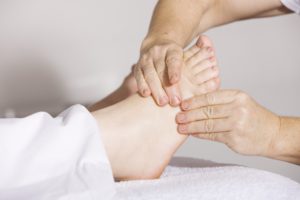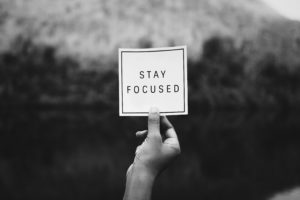Running is a great sport, that you can do anytime, anywhere, and without any club membership fee. But it may not be easy to get into running if you are a beginner. What’s the best way to start? How will you stay motivated? And what kind of gear will you need?

This article will provide you with practical tips on how to prepare for running and how to get started safely. You can print our free training plan for beginners, which will guide you step-by-step from an easy walk up to 5km non-stop run within 14 weeks. Get yourself ready for your first 5k race!
First things first – WHY do you run?
Especially in the first few weeks, it may be hard to stay motivated and stick to the plan. It’s because up until now, running hadn’t been a recurring activity in your weekly schedule. Knowing why you initially started to run, will help you recognize when you’re making false excuses. And it will help you regaining motivation to continue with the training plan.
 It is a personal choice to start running and the reason for it is personal too. Often the “why” is about wanting to change something, like improvement of endurance and fitness levels, or because you’ve always wanted to run a specific running distance or enter a specific race. Or because we’d like to lose weight, relieve some emotional stress, or simply because of the joy of being active outdoors. Others like to run to raise money for a charity or perform a Personal Best (PB), or Personal Record(PR). Whatever your reason to start running, write it down to remind you of it when the going gets tough.
It is a personal choice to start running and the reason for it is personal too. Often the “why” is about wanting to change something, like improvement of endurance and fitness levels, or because you’ve always wanted to run a specific running distance or enter a specific race. Or because we’d like to lose weight, relieve some emotional stress, or simply because of the joy of being active outdoors. Others like to run to raise money for a charity or perform a Personal Best (PB), or Personal Record(PR). Whatever your reason to start running, write it down to remind you of it when the going gets tough.
 Set SMART running goals
Set SMART running goals
Having a personal running goal, no matter how big or small can help you to stay focused. As you progress towards your goals, you will find that your motivation and enjoyment increase.
Make sure your running goals are Specific, Measurable, Achievable, Realistic, and Timely, for example: “By the end of the month I want to be able to complete my 2km run under 16 minutes”.
 Setting a goal that you won’t be able to achieve (at this point), will be demoralizing. So during your first sessions, find out what your level of fitness is. Once you know: you’ll also know what would be a suitable, achievable goal for your next run. Stay realistic and use some common sense when setting goals: running a marathon next week isn’t for most beginners. Create a deadline to work towards. Keep a log for your runs. Instead of guessing your running times and the distance that you have completed, it’s better to monitor your run with a GPS smartwatch or equivalent. Reflect on what went well and what should be improved when the deadline is due.
Setting a goal that you won’t be able to achieve (at this point), will be demoralizing. So during your first sessions, find out what your level of fitness is. Once you know: you’ll also know what would be a suitable, achievable goal for your next run. Stay realistic and use some common sense when setting goals: running a marathon next week isn’t for most beginners. Create a deadline to work towards. Keep a log for your runs. Instead of guessing your running times and the distance that you have completed, it’s better to monitor your run with a GPS smartwatch or equivalent. Reflect on what went well and what should be improved when the deadline is due.
 Prioritize & Plan your runs
Prioritize & Plan your runs
After setting your running goals it’s time to prepare for action and plan your first run! Plan when (date and time) you’ll go for your runs, what’s on the training schedule, with whom you’ll go and where. Choose whatever moment fits best in your weekly schedule, but plan your runs and write them down in your calendar. Make them high priority.
Map out a nice and scenic, traffic-free route that you can do in various weather conditions and at your scheduled time of the days. Make sure you have your running gear ready to put on when it’s time for training.
 Get good running gear
Get good running gear
Once your action plan is set, make sure you have the right gear to start off with. At the bottom of this article, you’ll find a list of all kinds of running gear that might be useful, but most important is to wear good footwear. To prevent any discomfort and injuries, don’t wear old and worn-out shoes. Not even “just for walking”. My advice is to find a specialist running store to get the shoes that offer the support and protection where your feet need it most. Trust me, bad shoes will ruin your runs. Also, invest in good quality running socks, which stay in place and that are made of sweat-wicking fabric to avoid getting blisters.
Other items to consider are runners clothing, a running belt, armband for your phone, headset, UV skin protection (sunscreen, sunglasses, running cap), and a GPS smartwatch.
Always check the weather forecast before you head out for your run, so you can protect yourself against sun, rain or wind. And make sure you’ll keep yourself hydrated.
 Running buddy
Running buddy
Some people like to run solo whilst others find it motivating to run with a running buddy. If you prefer to run together, make sure you both are at the same fitness level and running pace.
Progress
Collecting some data such as mileage, pace and heartbeat may be useful to log your runs. Keeping a running will make it easier to monitor your progress over the weeks. CLICK & SAVE :
–> MoreFun2Run Running Log <–
 Promise yourself a Reward
Promise yourself a Reward
An instant reward to look forward to will make it easier for you to stick to your plan. Treat yourself to something nice, straight after your achievement. If losing weight is one of your goals, make sure your reward is in line with a healthy lifestyle. Find some nice and healthy recipes and get the ingredients for tasteful, protein-rich, post-workout smoothies. Promise yourself to book a massage to soothe your muscle aches or have a relaxing pedicure treatment for tired runner’s feet. Of course, you could also reward yourself with cool, new running gear! 😉
 Training
Training
Ready? Set? Go! The 0-5km training schedule will guide you step-by-step from 0 to 5K non-stop running in 14 weeks. Print it and stick it to your fridge door!

1. Intensity will gradually increase
It is important to prepare your body and get into the habit of “regular exercising”. That’s why you will be doing (brisk) walks during the first few training sessions. Gradually you will build up the intensity with “Run & Walk” intervals. The intervals will become more challenging over the weeks that follow.

2. Never skip the walks
Please don’t make the mistake that many beginners make by skipping the walks in between the runs. Because the walks are very important to allow your muscles, ligaments, and joints to recover from each run. They are essential to strengthen your body and prevent injuries.
3. Endurance, distance, and pace will improve
After a few weeks, you’ll be running faster and you’ll cover longer distances without adding workout time to your schedule. From week 8 and onward in the schedule you will gradually improve your endurance. Step-by-step you will go from “run & walk” intervals to non-stop-running.
 4. Training intensity adjustments
4. Training intensity adjustments
Ideally, you’ll follow the schedule every week and complete the program within a maximum of 14 weeks in total. Some people could use a bit of extra challenge and speed up the runs or the program, whilst others need to slow down at some point:
- The running pace is most effective if you are able to keep up a conversation. If you can’t, because of heavy breathing, then you should slow down your pace.
- If you feel that you could use a bit more of a challenge, you could try a higher pace during the runs or skip 1 week ahead in the training schedule.

- If you are struggling with the training intensity of this week, repeat the same sessions for another week.
- The long-run training sessions may be too challenging at some point. It is OK to push yourself a little bit as it will make you stronger but always listen to your body. In case the long run seems really too much for one training session, then split the long run in half between morning and afternoon.
 Be optimistic and patient to reach for success
Be optimistic and patient to reach for success
If you are persistent in running regularly, a lot of positive changes will happen inside your body. They may not be visible in the mirror or on the scales after your first few runs, but after a while, you (and people around you) will notice things! Don’t give up. Just continue with the training plan. Be optimistic and patient. If you combine this training schedule with healthy nutrition, visible results will appear faster!
The best running gear for beginners
- Running Shoes (Asics is a good brand that I like to wear, but Brooks, Saucony, and Hoka are good quality brands too. Find out, what kind of support your feet need, to prevent discomfort and injuries! Don’t just select a shoe based on color and style. )
- Running Socks (I prefer Falke running socks, but there are many brands. Make sure the material is antibacterial, sweat-wicking and the right size to prevent blisters)
- Running Armband (it will depend on the brand and size of your phone that you’d like to take along during your runs. Make sure the material is sweat proof)
- Headphones
- Running Belt (I recommend the FlipBelt, because it carries all I need to take with me without chafing or bouncing during my runs)
- Runners wear like tights, shirts, shorts, jackets, bras & hats (Depending on weather conditions and personal taste. Please choose sweat-wicking (non-cotton!) and UV protective materials to wear on your skin)
- Running GPS Watch (depends on your budget and which features you wish. GPS function, interval timer, and heart rate monitor may be very practical)
- UV protection items: sunscreen /caps/sunglasses
 Believe in yourself and don’t give up!
Believe in yourself and don’t give up!
Some days you’re really not at your best. That’s ok, every runner has them every now and then. Believe in yourself, and shift your mind to the next training session. Keep on smiling and don’t give up!
I hope this article was useful and helped you start (and enjoy) running! If you’ve decided to get started with the MoreFun2Run 0-5km training schedule, let me know how you are doing. Please share this post through the social media buttons below. Thank you! For questions or additional tips, you can send me an e-mail at an*******@mo*********.com or leave your comment below.
1





It was so much fun to read through your post, it is amazingly organized and well put. I absolutely love your website feel, content, and quality. Good gear and training buddy are two of the hurdles I am facing for my startup. Also, the COVID crisis broke my routine so that’s that but I will get on track, your post has motivated me! Thank you!
Hii, Thank you for your kind words. Many people’s exercise routines have changed by COVID-19, but thankfully many countries are slowly lifting restrictions. This will make it easier for us to get back into running again. Check out these articles on how to choose the right shoes and why to invest in good running socks to prevent blisters. Getting these two items, will make it already possible for you to get (re-)started. All other running gear can wait until “later”. Maybe you’d like to start off alone to find out your current fitness level first, and then finds an equal running buddy. I wish you heaps of luck. Stay safe and healthy! I wish you MoreFun2Run! Let me know how you go!
Thank you so much for this wonderful article, Angelique! I love to run (I ran track in high school and regularly jog), and I actually want to run at least one marathon during my lifetime. I have talked to people who have run multiple marathons, and they all say the same thing-discipline, endurance, stamina, practice, increased speed, determination and faith will go a long way. I really appreciate how thorough you were in addressing the tips, how they make a difference in your running, and why we should take those tips to heart. I have saved your article, and will definitely share it with my friends and family. God bless you!
Thanks! Indeed, Anything is possible, as long as we really want it, and if we are disciplined to perform the training to reach our running goals. I would like to add that we shouldn’t forget the resting time. Rest in terms of active recovery. Because our bodies need time to recover from all the training as well. If you’d like to read more about that, check out an other article I wrote: Active recovery for runners after too much training. Let me know how you will go with the preparations of your marathon. I’ll write another article with training schedules for intermediate runners soon. Just keep posted!
Hi Angelique! I started running about a year but on and off. The most I got to was 2-3 times a week half hour jog. Now I’m lucky to do once – twice a week but I do feel my stamina and experience has improved. I warm up gradually with a slow jog, sprint in the middle and cool down with a slow jog towards the end and walk for 5-10mins after the 30 mins. Am I doing well ? How would you rate me and what advise can you give me 🙂
Hi Mohammed, Thank you for your comment. I consider the 2-3 times per week jogging for 30 minutes as a healthy form of regular physical exercise. Because you’ve been running on and off, I understand that you’ll need some time to get back into that routine. I would rather advise you to do a 5 minutes brisk walk as warming up, than “easy jogging” as that is easier on your muscles, tendons, and ligaments and will protect you better against injuries. Check out the training schedule and see at which level (which week in the program) you are right now in terms of endurance and fitness level. Move up from there and then gradually progress towards 5km non-stop run. Additionally, I would like to recommend to you to perform some Basic strength exercises for running in between your runs. You’ll have so much benefits from them, trust me. I wish you good luck. let me know if I can help you out more. And let us know how your progress is going!
I always wanted to do a regular run but time never allowed it. Now we have the time and looking at your recommendations for the running shoes, I’m up for it. Thank you for motivating me to fulfill my dream.
Best wishes
Habib
Hi, thank you for your comment. I hope you will truly get into running and will learn to love it (like I do). let me know if you need any other tips or advice. I’ve learned the hard way and unfortunately suffered from injuries and other issues in the past. Since I’ve been wearing the right shoes , quality runners socks , and since I’ve added runners yoga for better flexibility and strengthening exercises , this has saved me from getting injured (so far). Let me know how you go on your runs!